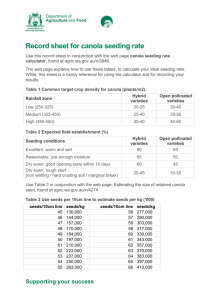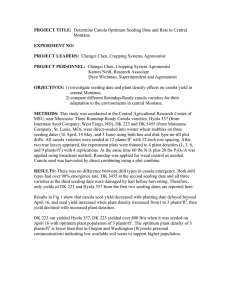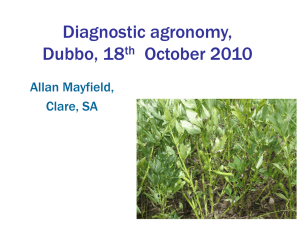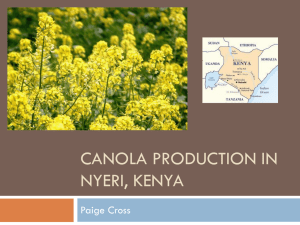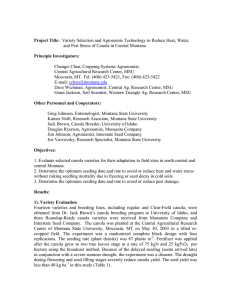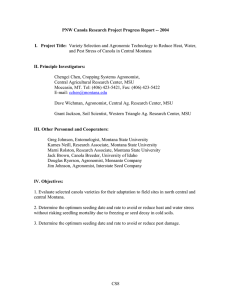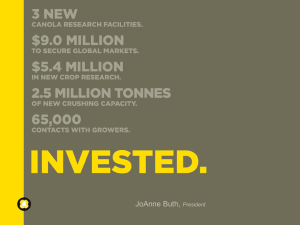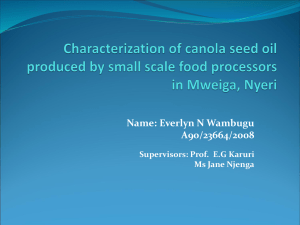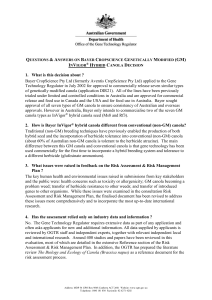GF2 SC Project Template - Example
advertisement
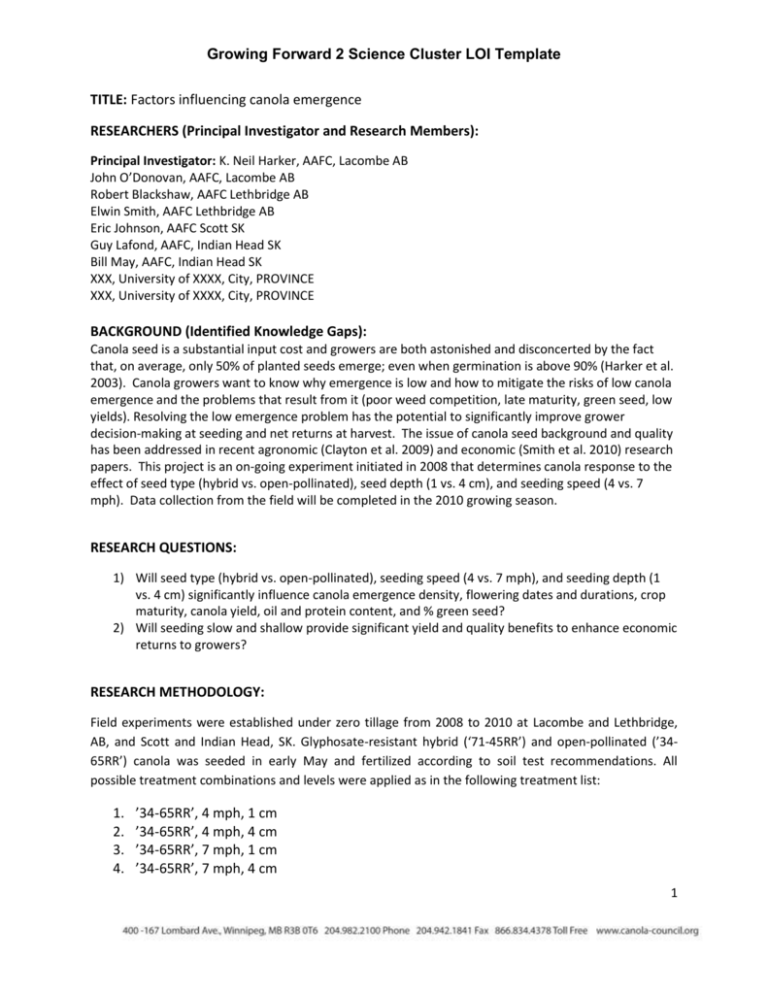
Growing Forward 2 Science Cluster LOI Template TITLE: Factors influencing canola emergence RESEARCHERS (Principal Investigator and Research Members): Principal Investigator: K. Neil Harker, AAFC, Lacombe AB John O’Donovan, AAFC, Lacombe AB Robert Blackshaw, AAFC Lethbridge AB Elwin Smith, AAFC Lethbridge AB Eric Johnson, AAFC Scott SK Guy Lafond, AAFC, Indian Head SK Bill May, AAFC, Indian Head SK XXX, University of XXXX, City, PROVINCE XXX, University of XXXX, City, PROVINCE BACKGROUND (Identified Knowledge Gaps): Canola seed is a substantial input cost and growers are both astonished and disconcerted by the fact that, on average, only 50% of planted seeds emerge; even when germination is above 90% (Harker et al. 2003). Canola growers want to know why emergence is low and how to mitigate the risks of low canola emergence and the problems that result from it (poor weed competition, late maturity, green seed, low yields). Resolving the low emergence problem has the potential to significantly improve grower decision-making at seeding and net returns at harvest. The issue of canola seed background and quality has been addressed in recent agronomic (Clayton et al. 2009) and economic (Smith et al. 2010) research papers. This project is an on-going experiment initiated in 2008 that determines canola response to the effect of seed type (hybrid vs. open-pollinated), seed depth (1 vs. 4 cm), and seeding speed (4 vs. 7 mph). Data collection from the field will be completed in the 2010 growing season. RESEARCH QUESTIONS: 1) Will seed type (hybrid vs. open-pollinated), seeding speed (4 vs. 7 mph), and seeding depth (1 vs. 4 cm) significantly influence canola emergence density, flowering dates and durations, crop maturity, canola yield, oil and protein content, and % green seed? 2) Will seeding slow and shallow provide significant yield and quality benefits to enhance economic returns to growers? RESEARCH METHODOLOGY: Field experiments were established under zero tillage from 2008 to 2010 at Lacombe and Lethbridge, AB, and Scott and Indian Head, SK. Glyphosate-resistant hybrid (‘71-45RR’) and open-pollinated (’3465RR’) canola was seeded in early May and fertilized according to soil test recommendations. All possible treatment combinations and levels were applied as in the following treatment list: 1. 2. 3. 4. ’34-65RR’, 4 mph, 1 cm ’34-65RR’, 4 mph, 4 cm ’34-65RR’, 7 mph, 1 cm ’34-65RR’, 7 mph, 4 cm 1 Growing Forward 2 Science Cluster LOI Template 5. 6. 7. 8. ’71-45RR’, 4 mph, 1 cm ’71-45RR’, 4 mph, 4 cm ’71-45RR’, 7 mph, 1 cm ’71-45RR’, 7 mph, 4 cm EXPERIMENTAL DESIGN AND DATA ANALYSIS: The design was a randomized complete block with a factorial treatments arrangement (2 x 2 x 2) and four replications. Data will be analyzed using ANOVA (PROC MIXED SAS) with SS partitioned for preplanned contrasts. DATA COLLECTION: All Years Gravimetric soil moisture at the time of seeding, crop emergence dates and counts, overhead digital photos for % green canopy cover, initiation and completion of flowering dates, crop maturity date , crop seed yield, 1000 seed weight, canola oil and protein content. TIMELINES AND DELIVERABLES: 2010-11: The final year of the experiment will be conducted in the spring of 2010 at all sites. Data will be collected and summarized for a final progress report. 2011-12: The final year of funding will be dedicated to combined data analyses, report and scientific paper publication, and technology transfer activities. OUTPUTS: Canola growers will be informed of best management practices that will help to improve canola emergence and increase returns on canola seed costs. PERFORMANCE INDICATORS: New information on best management practices for canola seeding will be disseminated through field tours, grower meetings, and CCC agronomists. In-conjunction with CCC a neuronetwork model will be developed to assist farmers in understanding the risk factors for stand establishment. Undergraduate students will be trained in agricultural research procedures. A scientific paper and extension fact sheets will be published at the conclusion of this study. BUDGET TOTALS BY YEAR: Total Project Cost: $63,000 over 2 years 2 Growing Forward 2 Science Cluster LOI Template REFERENCES: Clayton, G. W., S. Brandt, E. N. Johnson, J. T. O’Donovan, K. N. Harker, R. E. Blackshaw, E. G. Smith, H. R. Kutcher, C. Vera, and M. Hartman. 2009. Comparison of certified and farm-saved seed on yield and quality characteristics of canola. Agron. J. 101:1581-1588. Harker, K. N., G. W. Clayton, R. E. Blackshaw, J. T. O’Donovan and F. C. Stevenson. 2003. Seeding rate, herbicide timing and competitive hybrids contribute to integrated weed management in canola (Brassica napus). Can. J. Plant Sci. 83:433-440. Smith, E. G., M. L. Favret, G. W. Clayton, R. E. Blackshaw, S. Brandt, E. N. Johnson, K. N. Harker, J. T. O’Donovan, H. R. Kutcher, and C. Vera. 2010. The profitability of seeding the F2 generation of hybrid canola. Agron. J. 102:598-605. 3
